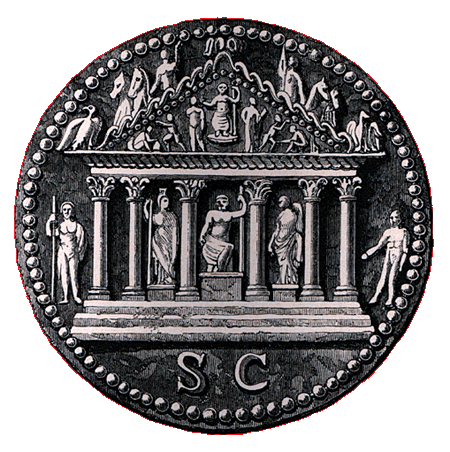
This is a drawing of a coin issued by the emperor Vespasian to commemorate his rebuilding of the Temple of Jupiter on the Capitoline in 69 CE (see original coin). This was the second time that the temple had been re-erected. The earliest temple to the Capitoline Triad had been built by Tarquinius Superbus as a monument to the power of the monarchy, but he was overthrown and killed before the temple had been completed. The actual dedication of the temple, therefore, took place during the first year of the Roman Republic (traditionally dated to 509 BCE), so the temple came to symbolize republican, rather than monarchical power. The earliest temple was designed in the Etruscan style, with a nearly square foundation, a high podium built of tufa, stuccoed stone Doric columns on the porch, and a wooden entablature (see this model of a simpler Etruscan temple). The cult statues and sculptures on the pediment and roof were made of painted terra-cotta. The terra-cotta cult statue of Jupiter, made by a famous Etruscan sculptor, was dressed in a purple toga embroidered with gold and had its face painted red; the dress worn by victorious generals in a triumphal parade imitated this statue of Jupiter.
The first temple was struck by lightning in 83 BCE and burned to the ground. The dictator Sulla began rebuilding the temple on the same foundations but did not complete it; the new temple was finally dedicated by the former consul Q. Lutatius Catulus in 69 BCE. This temple preserved the basic structure of the first but was more magnificent, with even greater height, marble columns, and gilded bronze roof tiles. By the accession of Augustus, this temple had fallen into disrepair, and the new princeps restored and reworked it.
However, after the death of Nero the temple fell victim to the riots and struggle for imperial power during what has come to be called "the year of the four emperors" (69 CE). The Capitoline Hill was stormed by the supporters of Vitellius, and the temple was again burned to the ground. When Vespasian became emperor, he immediately rebuilt the temple (Suetonius tells us he personally cleared away the first load of rubble). Vespasian increased the height of the temple and used marble Corinthian columns and marble sculptures but preserved the original footprint and overall design of the temple. Tacitus tells us that this was in accordance with divine command:
Id facinus post conditam urbem luctuosissimum foedissimumque rei publicae populi Romani accidit, nullo externo hoste . . . sedem Iovis Optimi Maximi auspicato a maioribus pignus imperii conditam, quam non Porsenna dedita urbe neque Galli capta temerare potuissent, furore principum excindi. . . . Curam restituendi Capitolii in Lucium Vestinum confert, equestris ordinis virum, sed auctoritate famaque inter proceres. ab eo contracti haruspices monuere ut reliquiae prioris delubri in paludes aveherentur, templum isdem vestigiis sisteretur: nolle deos mutari veterem formam. (Histories 3.72; 4.53)
After the foundation of the city, the most lamentable and vilest deed that befell the republic of the Roman people was the utter destruction of the Temple of Jupiter Optimus Maximus, founded under good auspices by our ancestors as a guarantee of our power, not by an external enemy (for neither Porsenna, when the city had been surrendered, nor the Gauls when it had been captured, were able to desecrate this temple) but through the madness of our emperors. Vespasian gave Lucius Vestinus the task of restoring the Capitolium; he was a man of the equestrian order but in authority and prestige was classed among the nobles. The diviners he employed warned that the relics from the previous sanctuary should be carried off into the swamps, and that the temple should be placed on the same foundations -- the gods did not want the old form to be changed.
Vespasian's temple burned down in 80 CE, and the temple as it now stands was rebuilt by Domitian in his usual flamboyant style; he dedicated the new temple with elaborate ceremonies in 89 CE.